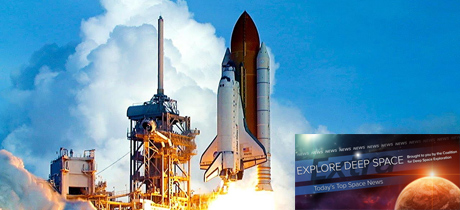In Today’s Deep Space Extra… Space shuttle Atlantis launched for the last time 10 years ago today. NASA experts continue to pinpoint the cause of a malfunction on the Hubble space telescope.
Human Space Exploration
On This Day in Space! July 8, 2011: Space Shuttle Atlantis launches on final mission
Space.com (7/8): Atlantis was the last of NASA’s space shuttles to fly into space, on mission STS-135. By the end of this final flight, it had traveled 126,000,000 miles and orbited Earth 4,848 times.
Space Science
Methane in plume of Saturn’s moon Enceladus could be sign of alien life, study suggests
Space.com (7/7): Data from NASA’s Cassini mission, which orbited Saturn, suggests signatures of methane gas rising from the moon Enceladus may be a sign of biological activity. But there are other possible explanations. For example, it’s feasible that the icy moon features some types of abiotic methane-producing reactions that aren’t prevalent here on Earth, perhaps the decay of primordial organic matter left over from the moon’s birth, researchers said. Findings were published in the journal Nature Astronomy.
Supply chain, Artemis program limits SLS use for science
SpaceNews.com (7/8): The SLS’s performance interests scientists proposing missions to the outer solar system. The SLS Block 2 can send payloads of 10 tons directly to Jupiter, and nearly as much to Saturn with a gravity assist. The use of additional stages can even double that payload and enable direct missions to Uranus and Neptune. In a briefing about the rocket to the steering committee of the planetary science decadal survey yesterday, however, Robert Stough of NASA’s Marshall Space Flight Center said that if scientists are planning missions that require the SLS, they could secure manifest slots for no earlier than the late 2020s or early 2030s. “Given the demands of the Artemis program between now and the late 2020s, it’s going to be very difficult to squeeze a science mission in that time frame.” Stough also talked about comments on the cost of the vehicle and took issue with some estimates. “The cost numbers you hear in the media are typically inflated,” he said.
The Hubble Space Telescope is facing its most serious glitch in a decade and NASA really wants to fix it
Space.com (7/7): NASA experts are continuing to pinpoint the cause of a malfunction, once thought to be within the primary computer, that forced the Hubble Space Telescope to suspend science operations on June 13. “Other than the fact that this particular anomaly means the observatory can’t work until we solve it, I don’t think solving it is different in kind than other anomalies that NASA deals with,” Paul Hertz, NASA’s director of astrophysics, told Space.com. Hubble was launched in 1990 and was last serviced by NASA space shuttle astronauts in 2009.
Other News
NOAA to take first step toward a small satellite constellation
Coalition Members in the News – L3Harris, Lockheed Martin, Maxar Technologies, Northrop Grumman, United Launch Alliance
SpaceNews.com (7/7): The National Oceanic and Atmospheric Administration (NOAA) is assessing how small Earth orbiting satellites might provide essential data for weather forecast models. Instead of flying satellites the size of pickup trucks like the current Joint Polar Satellite System (JPSS), NOAA is exploring the benefits of feeding data supplied by a constellation of small satellites in low Earth orbit into weather forecast models. The U.S. Space Force is assessing the concept as well, and the European Space Agency is developing a prototype for a constellation of small Arctic Weather Satellite spacecraft.
Satellite operator Planet to go public in $2.8B SPAC merger
Tech Crunch (7/7): Planet, which operates a network of around 200 satellites that provides Earth imaging, as well as analytics of the data derived from that observation, is going public in a merger with special purpose acquisition company (SPAC) dMY Technology Group IV. The deal has a post-transaction equity value of $2.8 billion.

